Tutorials
Learn More
Multiplexer
A multiplexer (MUX) is a combinational circuit that connects any one input line (out of multiple N lines) to the single output line based on its control input signal (or selection lines)
Usually, for ‘n’ selection lines, there are N = 2^n input lines.
Nomenclature: N:1 denotes it has ‘N’ input lines and one output line.
2:1 Multiplexer
2:1 MUX has 2 input lines and one select line.
Block Diagram
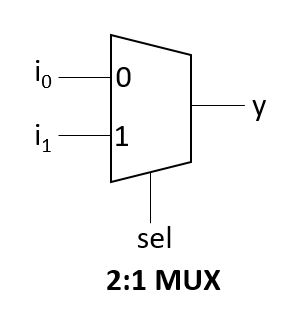
Truth Table
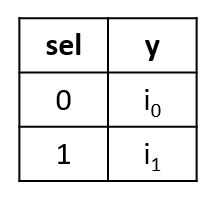
2:1 MUX Verilog Code
module mux_2_1(
input sel,
input i0, i1,
output y);
assign y = sel ? i1 : i0;
endmoduleTestbench Code
module mux_tb;
reg i0, i1, sel;
wire y;
mux_2_1 mux(sel, i0, i1, y);
initial begin
$monitor("sel = %h: i0 = %h, i1 = %h --> y = %h", sel, i0, i1, y);
i0 = 0; i1 = 1;
sel = 0;
#1;
sel = 1;
end
endmoduleOutput:
sel = 0: i0 = 0, i1 = 1 --> y = 0
sel = 1: i0 = 0, i1 = 1 --> y = 14:1 Multiplexer
4:1 has 4 input lines and two select lines.
Block Diagram
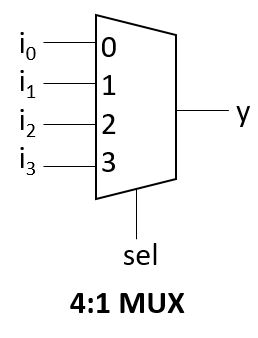
Truth Table
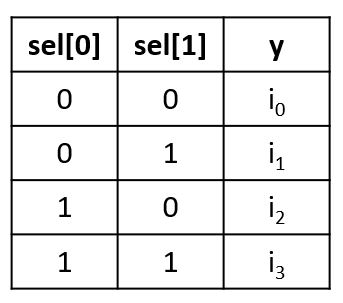
4:1 MUX Verilog Code
module mux_example(
input [1:0] sel,
input i0,i1,i2,i3,
output reg y);
always @(*) begin
case(sel)
2'h0: y = i0;
2'h1: y = i1;
2'h2: y = i2;
2'h3: y = i3;
default: $display("Invalid sel input");
endcase
end
endmoduleTestbench Code
module tb;
reg [1:0] sel;
reg i0,i1,i2,i3;
wire y;
mux_example mux(sel, i0, i1, i2, i3, y);
initial begin
$monitor("sel = %b -> i3 = %0b, i2 = %0b ,i1 = %0b, i0 = %0b -> y = %0b", sel,i3,i2,i1,i0, y);
{i3,i2,i1,i0} = 4'h5;
repeat(6) begin
sel = $random;
#5;
end
end
endmoduleOutput:
sel = 00 -> i3 = 0, i2 = 1 ,i1 = 0, i0 = 1 -> y = 1
sel = 01 -> i3 = 0, i2 = 1 ,i1 = 0, i0 = 1 -> y = 0
sel = 11 -> i3 = 0, i2 = 1 ,i1 = 0, i0 = 1 -> y = 0
sel = 01 -> i3 = 0, i2 = 1 ,i1 = 0, i0 = 1 -> y = 04:1 MUX using 2:1 MUXes
Block Diagram
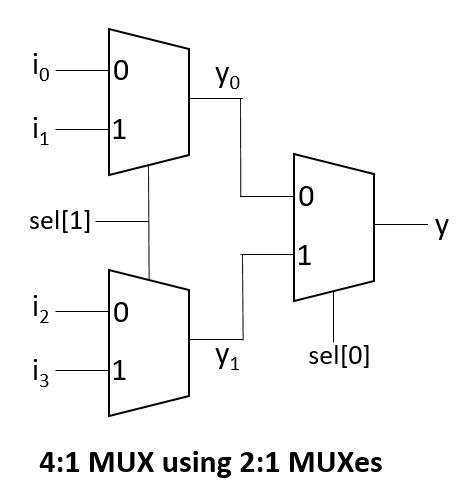
4:1 MUX using 2:1 MUXes Verilog Code
module mux_2_1(
input sel,
input i0, i1,
output y);
assign y = sel ? i1 : i0;
endmodule
module mux_4_1(
input sel0, sel1,
input i0,i1,i2,i3,
output reg y);
wire y0, y1;
mux_2_1 m1(sel1, i2, i3, y1);
mux_2_1 m2(sel1, i0, i1, y0);
mux_2_1 m3(sel0, y0, y1, y);
endmoduleTestbench Code
module tb;
reg sel0, sel1;
reg i0,i1,i2,i3;
wire y;
mux_4_1 mux(sel0, sel1, i0, i1, i2, i3, y);
initial begin
$monitor("sel0=%b, sel1=%b -> i3 = %0b, i2 = %0b ,i1 = %0b, i0 = %0b -> y = %0b", sel0,sel1,i3,i2,i1,i0, y);
{i3,i2,i1,i0} = 4'h5;
repeat(6) begin
{sel0, sel1} = $random;
#5;
end
end
endmoduleOutput:
sel0=0, sel1=0 -> i3 = 0, i2 = 1 ,i1 = 0, i0 = 1 -> y = 1
sel0=0, sel1=1 -> i3 = 0, i2 = 1 ,i1 = 0, i0 = 1 -> y = 0
sel0=1, sel1=1 -> i3 = 0, i2 = 1 ,i1 = 0, i0 = 1 -> y = 0
sel0=0, sel1=1 -> i3 = 0, i2 = 1 ,i1 = 0, i0 = 1 -> y = 03:1 Multiplexer
In 3:1 MUX, for two select inputs (sel = 2’b01 and sel = 2’b11), same input (i2) will be driven to the output y.
Block Diagram
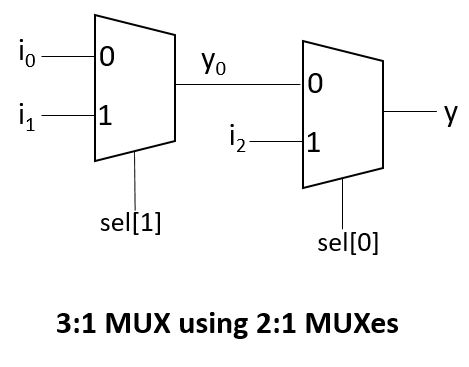
Truth Table
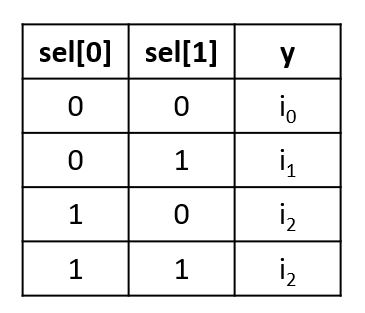
3:1 MUX Verilog Code
module mux_2_1(
input sel,
input i0, i1,
output y);
assign y = sel ? i1 : i0;
endmodule
module mux_3_1(
input sel0, sel1,
input i0,i1,i2,i3,
output reg y);
wire y0, y1;
mux_2_1 m1(sel1, i0, i1, y0);
mux_2_1 m2(sel0, y0, i2, y);
endmoduleTestbench Code
module tb;
reg sel0, sel1;
reg i0,i1,i2,i3;
wire y;
mux_3_1 mux(sel0, sel1, i0, i1, i2, i3, y);
initial begin
$monitor("sel0=%b, sel1=%b -> i3 = %0b, i2 = %0b ,i1 = %0b, i0 = %0b -> y = %0b", sel0,sel1,i3,i2,i1,i0, y);
{i3,i2,i1,i0} = 4'h5;
repeat(8) begin
{sel0, sel1} = $random;
#5;
end
end
endmoduleOutput:
sel0=0, sel1=0 -> i3 = 0, i2 = 1 ,i1 = 0, i0 = 1 -> y = 1
sel0=0, sel1=1 -> i3 = 0, i2 = 1 ,i1 = 0, i0 = 1 -> y = 0
sel0=1, sel1=1 -> i3 = 0, i2 = 1 ,i1 = 0, i0 = 1 -> y = 1
sel0=0, sel1=1 -> i3 = 0, i2 = 1 ,i1 = 0, i0 = 1 -> y = 0
sel0=1, sel1=0 -> i3 = 0, i2 = 1 ,i1 = 0, i0 = 1 -> y = 1Verilog Codes